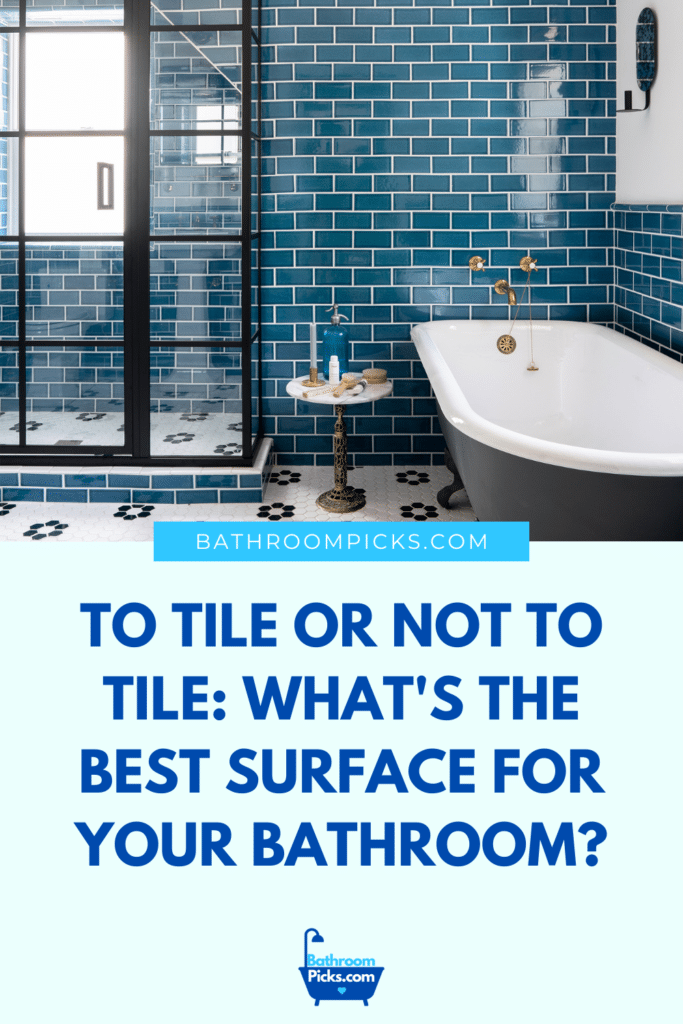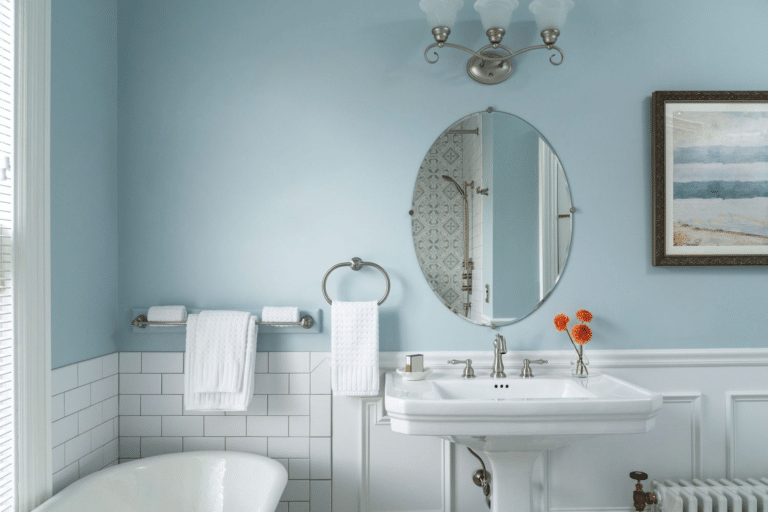To Tile or Not to Tile: What’s the Best Surface for Your Bathroom?
Back in my 30s, a bathroom wasn’t quite a bathroom if it wasn’t decked out in tiles from floor to ceiling. It was the golden rule, the unwritten law of bathroom decor. But fast forward to today, and it’s like we’ve stepped into a whole new world of bathroom design! Everywhere I look, I see these sleek, contemporary bathrooms embracing minimalism and experimenting with exciting new materials. Honestly, they’re so gorgeous, it makes me wish I had two bathrooms at home—just so I could indulge in both styles! But, alas, such is life; choices must be made.
So, here you are, possibly pondering the same dilemma. Whether you’re renovating or just daydreaming about your future palace of cleanliness, this article is here to help. We’ll dive into the classic appeal of tiles and explore the fresh allure of non-tile materials. By the end, I hope to help you decide—or at least lean towards—a style that resonates with you. Let’s get started, shall we?

Tiling the Bathroom – A Classic Solution

Tiles often become the go-to solution for most homeowners, and they’ve earned that place for good reasons. They offer unmatched versatility in color, pattern, and texture, are easy to maintain, and enhance home value, making them a practical and attractive choice for bathroom renovations.
When I think of bathroom tiles, I’m instantly transported to a world of endless possibilities. Let’s break down what makes tiling such a tried and true option.
Types of Bathroom Tiles
Over the years, I’ve seen everything from the humble ceramic to the regal porcelain and even the oh-so-natural stone tiles. Each type brings its own flavor to your bathroom:
Ceramic Tiles:
Often the first choice for many, ceramic tiles are the quintessential bathroom material. They’re crafted from clay and baked to perfection, resulting in a sturdy surface that can handle the wear and tear of everyday bathroom use. The real charm of ceramic tiles lies in their versatility.

Whether you’re looking for a vibrant pattern to add some zest to your space or a subtle shade to create a calm oasis, ceramic tiles come in an array of options that won’t strain your budget. Plus, they’re easy to install, making them a favorite for DIY enthusiasts.
Porcelain Tiles:
Step up from ceramic, porcelain tiles offer enhanced properties that make them a stellar choice for bathrooms. Made from finer clay and fired at higher temperatures, they are denser and less porous than their ceramic cousins. This makes them exceptionally resistant to moisture, staining, and wear.

Porcelain tiles are ideal for those high-traffic areas or bathrooms exposed to heavy moisture. While they might be pricier, their longevity and sleek appearance justify the investment, ensuring your bathroom floor remains timeless and elegant.
Stone Tiles:
For those looking to inject a touch of natural beauty and luxury into their bathrooms, stone tiles are the way to go. Materials like marble, granite, and slate not only elevate the aesthetic but also add a unique textural element to your space. Each stone tile is distinct, with natural veins and color variations that can’t be replicated in synthetic materials.

Marble tiles add a sophisticated touch, granite offers robust durability, and slate provides a rustic charm that can transform your bathroom into a luxurious retreat. Though stone tiles require more maintenance to keep them looking pristine, they are a worthwhile investment for that opulent, spa-like vibe.
Each type of tile brings its own set of advantages and aesthetic qualities to a bathroom, catering to different tastes, budgets, and practical needs. Whether you choose ceramic, porcelain, or stone, each option promises to enhance the functionality and beauty of your bathroom space.
Embracing the New Trend of Non-Tile Bathrooms in Modern Design
Gone are the days when tiles were the only game in town for bathroom finishes. The design world has been buzzing with innovative materials that challenge the traditional tiled look, bringing a fresh wave of style to modern bathrooms. Let’s explore some of these exciting alternatives and what they bring to the table.
Types of Non-Tile Bathroom Solution
As people start to accept more and more personal concepts in their home decor, innovative non-tile solutions are becoming increasingly popular for those looking to express their unique style in bathroom design.
Waterproof Paint:

If you’re looking for a budget-friendly alternative that doesn’t skimp on style, waterproof paint might be your best bet. Available in a limitless array of colors, this option allows you to splash your personality across your bathroom walls without the worry of moisture damage. It’s perfect for achieving a seamless look that can make small spaces appear larger and more cohesive.
Wall Panels:

Another fantastic option that’s gaining traction are wall panels. These panels come in materials such as acrylic, PVC, and laminated composites, offering a smooth, grout-free finish. They are incredibly easy to install—often just needing to be glued or clicked into place—and provide a modern look with minimal effort. Wall panels are also a dream to clean, with most requiring just a simple wipe down to keep them looking new.
Natural Stone and Other Luxurious Finishes:

For those who adore the natural appeal of stone but want something a bit different from traditional stone tiles, large slabs of marble, granite, or even engineered stone can be used. These materials provide a continuous, uninterrupted surface that exudes luxury and sophistication. While the initial cost may be higher, their stunning impact and durability make them a worthy consideration for any high-end bathroom renovation.
Concrete:

Industrial chic is in, and concrete is at the forefront of this trend. It offers a sleek, minimalist aesthetic that’s incredibly durable and versatile. Concrete can be polished, stained, or textured to match any decor style, and it brings an unexpectedly warm and organic feel to a space traditionally dominated by hard, glossy surfaces.
Each of these non-tile options offers a unique set of benefits that cater to different design preferences and practical considerations. Whether you’re drawn to the simplicity and ease of waterproof paint, the sleekness of wall panels, the luxury of natural stone, or the edgy vibe of concrete, there’s no shortage of ways to create a bathroom that stands out while standing up to the daily demands of home life.
Who Should Consider Tiling Their Bathroom?

In the vibrant world of bathroom design, choosing to tile your bathroom is not just about following tradition—it’s about making a practical decision that suits specific needs. Let’s consider who might benefit most from choosing tiles for their bathroom sanctuary.
High-Moisture Environments:
For bathrooms that face a lot of moisture and steam, especially those in busy households or with multiple showers a day, tiles are a blessing. Their resistance to humidity and water makes them an ideal choice for such environments, preventing moisture damage and mold growth.
Families with Young Children:
If you have little ones running around, you know that bathrooms can quickly become splash zones. Tiles are not only water-resistant but also easy to clean. Whether it’s bath time antics or sink splashes, a quick wipe down is all it takes to keep tiled surfaces looking pristine.
Those Seeking Longevity and Durability:
Tiles are renowned for their durability. For homeowners who aren’t keen on frequent renovations, tiles offer a long-lasting solution that can endure the wear and tear of daily bathroom use. With proper installation and minimal maintenance, a tiled bathroom can look as good as new for years to come.
Aesthetics Enthusiasts:

For those who have a specific design vision, tiles offer unmatched versatility. Whether you’re looking for a sleek modern look with large format tiles or a quaint, rustic vibe with hand-painted ceramic tiles, the possibilities are endless. Tiles can be laid in various patterns like chevrons, herringbones, or basket weaves to add an extra layer of design interest.
Home Value Consideration:
If you’re planning to sell your home in the future, a beautifully tiled bathroom can be a significant selling point. It’s a feature that many homebuyers appreciate for its aesthetic appeal and practical benefits, potentially increasing the overall marketability of your property.
For anyone weighing the pros and cons of different bathroom finishes, tiles offer a tried-and-true option that combines functionality with aesthetic flexibility, making them suitable for a wide range of personal styles and practical needs.
Opting for a Bathroom Without Tiles

While tiling has long been a traditional favorite, many homeowners are now exploring the path less trodden with non-tile bathroom finishes. Let’s look at who might benefit from choosing a bathroom without tiles and why this might be the right choice for them.
Seekers of Seamless Style:
For those drawn to sleek, uninterrupted surfaces, non-tile options like large wall panels or continuous stone slabs can offer a visually clean and modern aesthetic. These materials reduce visual clutter and create a sense of calm and spaciousness, ideal for minimalist designs.
Renovators on a Budget:
If budget constraints are a significant consideration, alternatives such as waterproof paint or affordable acrylic wall panels can be a cost-effective solution. These options are typically less expensive than high-end tiles and can still provide a durable and stylish finish.
DIY Enthusiasts:
For the hands-on homeowner, installing wall panels or applying waterproof paint can be a more manageable DIY project compared to tiling, which often requires specialized skills and tools. These non-tile solutions can be quicker to install and don’t require the same level of craftsmanship, making them suitable for those who enjoy weekend renovation projects.
Eco-Conscious Individuals:
For those looking to reduce their environmental impact, certain non-tile materials offer eco-friendly benefits. Recycled glass panels, for example, provide a unique and sustainable option, while certain types of concrete can be mixed with recycled materials.
Innovators and Trendsetters:

Homeowners who love to stay ahead of home design trends might prefer materials like polished concrete, which caters to contemporary and industrial styles, or resin, which can be customized with colors and patterns for a personal touch. These materials often appeal to those looking to make a bold statement in their home.
Opting for non-tile materials can offer a fresh perspective on bathroom design, blending functionality with the opportunity for personal expression. Whether it’s the simplicity of paint, the sleekness of panels, or the modern feel of concrete, each option presents a unique set of advantages that cater to different lifestyles and aesthetic preferences.
That’s a Beautiful Competition!
That’s it, folks! I hope I’ve sparked some inspiration for your next bathroom makeover. Will you stick with the classic elegance of tiles, or are you ready to venture into the bold world of non-tile materials? Each path offers its own unique charm and set of advantages, perfectly tailored to suit your style and meet your needs.
So, what’ll it be? I’m on the edge of my seat waiting to hear which direction you’ll choose! Drop a comment below with your decision—I’m eager to see your fabulous choices and hear all about your renovation adventures. Let’s make those bathroom dreams a reality!


